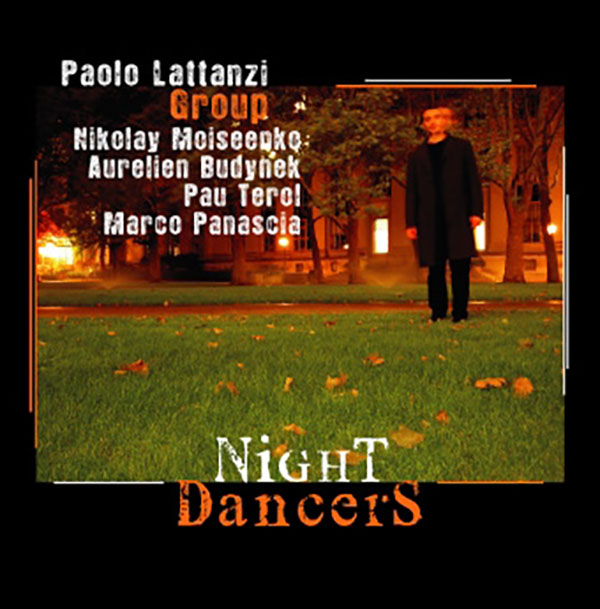
by Ian Mann
December 12, 2006
/ ALBUM
Taken as a whole this is a very promising debut album from Lattanzi. His compositions are always interesting and cover a wide stylistic and dynamic range.
This latest release from the excellent Italian label Silta features the thoughtful compositions of drummer Paolo Lattanzi in a selection of intriguing original pieces. The album was recorded in Massachusetts and I suspect that Lattanzi is now actually based in the USA and is/was a student at the famous Berklee College of Music in Boston.
Lattanzi leads a quintet featuring Nikolay Moiseenko on alto and soprano saxes, Aurelien Budynek on guitar, Pau Terol on piano and organ plus Marco Panascia on acoustic and electric basses. There is some fine ensemble playing from the group throughout the album and some fine soloing from the individual members in a well-balanced programme.
The opening “Cicerchi’s Wanderlust” features the meaty, resonant tones of Panascia’s double bass in it’s opening bars and is a feature for both him and the talented pianist Pau Terol. Taken at medium tempo this is an excellent start.
“Just A Story” is more angular and funky and serves as a vehicle for Moiseenko’s dry biting alto. Lattanzi’s drums give dynamic support without resorting to the obvious rhythms.
14/2 is a ballad with dark edges. Panascia’s rich arco bass is followed by Budynek’s taut acoustic guitar. Moiseenko’s keening soprano weaves in and out of the piece and Lattanzi’s economic support and light cymbal touch show the subtle side of his playing.
“In A Dark Room” is less distinctive than what has gone before .It is a little too close to slick seventies style fusion for comfort with it’s smooth alto licks, electric bass and funk rhythms. However, it changes tempo in the middle of the piece and Lattanzi provides an interesting interlude led by the drums.
“When It Doesn’t Matter” is a return to ballad mode with Terol’s beautiful acoustic piano introduction emphasising the importance of the space between the notes.
Budynek’s relaxed unhurried guitar probings are true to the mood of the piece and Lattanzi’s delicate brushwork and Panascia’s low register bass add appropriate support. Moiseenko again slides in and out of the proceedings providing necessary punctuation and sometimes taking up the melody line.
“Other Lands” is as exotic and adventurous as it’s title would suggest. Terol takes a wry, slyly funky acoustic piano solo before Budynek takes the chance to rock out on electric guitar. Utilising unusual effects and signatures this is one of the outstanding solos on the album. Lattanzi and Panascia give excellent support, blending muscularity with subtlety.
The shifting metres of the title track provide an attractive showcase for Budynek and Moiseenko as the rhythm players wrestle with the complexities of the piece. However for the listener it’s a relaxing and pleasurable experience.
“Four Years Gone” is a brief vignette but the quintet fit a lot into a minute and a half! There is an attractive melody courtesy of Moiseenko and some great ensemble playing from the rest of the group.
The episodic “Fairy Tales To A Child” is arguably the album’s outstanding composition .It builds slowly in intensity through solos by Terol, Budynek, Moiseenko and Panascia. There is a shifting, cinematic quality to the music that maintains the attention.
The closing “May” has something of a blues feel with Terol on organ. However, it goes through more dynamic and stylistic changes than the average blues. Budynek once again cranks up his guitar and is the main soloist, again showing his rock influences. Lattanzi drums up a storm behind him. Moiseenko’s solo is more laid back but saxophone and guitar finally coalesce to bring the tune and the album to a rousing conclusion. “May” is one of the album’s better tunes and something of a live favourite one would imagine.
Taken as a whole this is a very promising debut album from Lattanzi. His compositions are always interesting and cover a wide stylistic and dynamic range.
The playing by all members of the group is of a uniformly high standard with Budynek and Panascia both catching the ear as distinctive soloists. Lattanzi himself is a fine drummer but Terol and Moiseenko sometimes become rather anonymous. Occasionally things can sound a little too dry and academic - and the group don’t always catch fire - but experience should spark that inspired looseness that paradoxically makes for the best jazz. There is considerable ability here and much potential for the future.
blog comments powered by Disqus